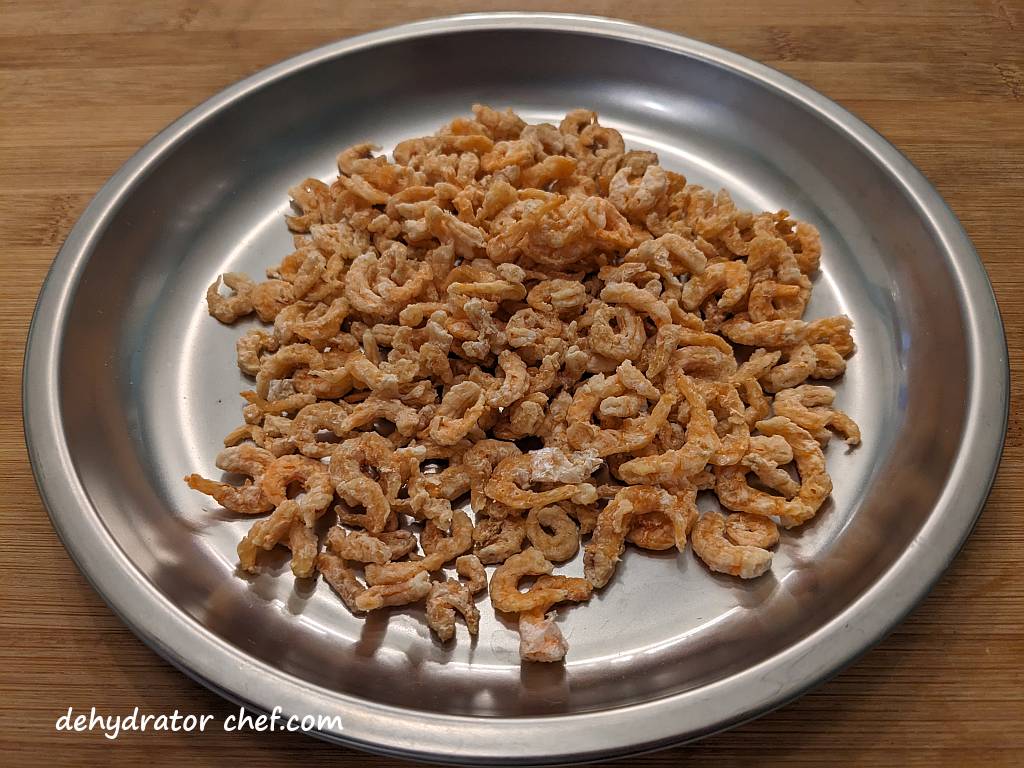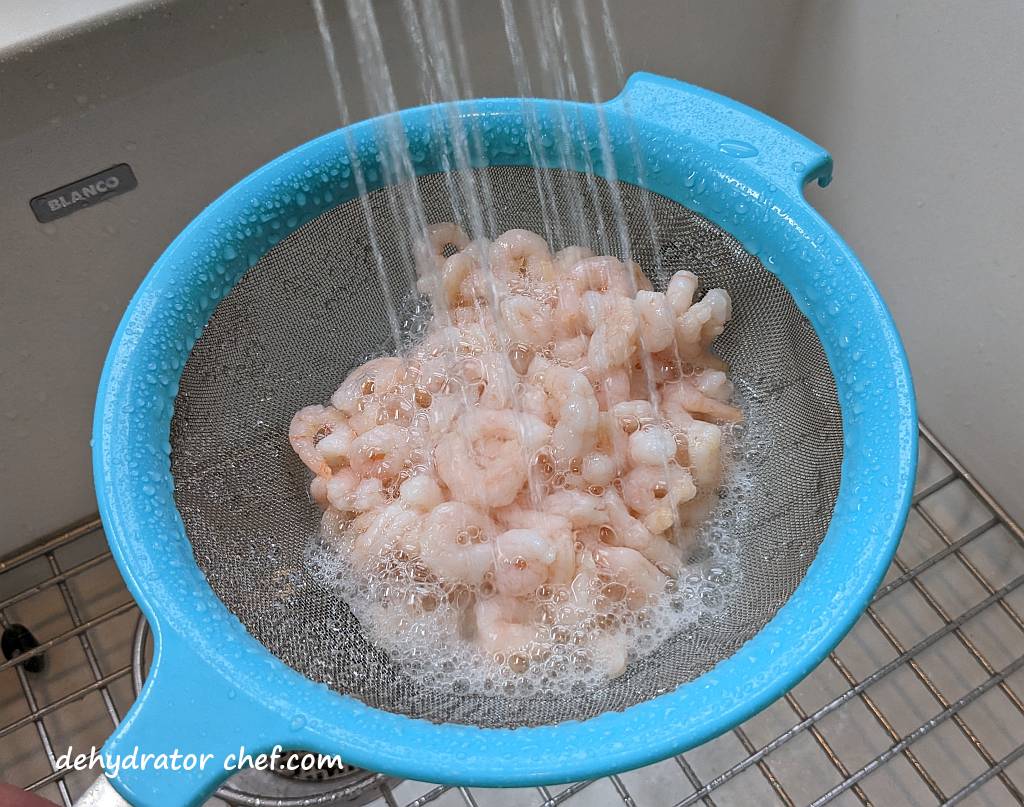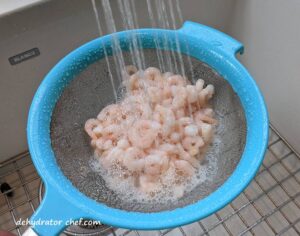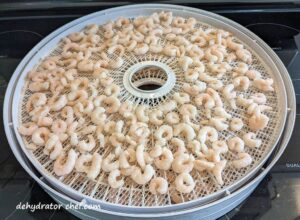Dehydrating food is a useful skill that can have various benefits, such as extending the shelf life of seasonal produce and creating your own emergency food supply. Today, we’ll be dehydrating shrimp, and we’ll provide you with a step-by-step guide to successfully dehydrate and preserve these tiny yet flavorful crustaceans.
We’ll be using previously frozen precooked salad shrimp for our dehydration project. These small-size shrimp are not only quick to dehydrate, but they also pack a punch of flavor and nutrition.

So, grab your dehydrator, and let’s get started!
Table of Contents
- How to Dehydrate Shrimp
- Supplies Needed for Dehydrating Shrimp
- Step 1. Process the Frozen Shrimp for Dehydrating
- Step 2. Preparing the Dehydrator for Dehydrating Shrimp
- Step 3. Dehydrating Shrimp
- Step 4. When are the Dehydrated Shrimp Done
- Step 5. Equalizing and Conditioning the Dehydrated Shrimp
- Step 6. Storing Dehydrated Shrimp
- How to Rehydrate Dried Shrimp
- Weights, Measures, and Serving Sizes
- Dehydrated Shrimp Nutrition Information
- How to Use Dehydrated Shrimp in Camping Meals
- Insider Tips
How to Dehydrate Shrimp
With the Dehydrator Chef approach, we want our dehydrated meals to reconstitute fairly quickly when we are prepping our food using a camp stove.

All you need to dehydrate these foods is a good quality food dehydrator. We use the Nesco food dehydrators. You can check out our food dehydrator guide to learn why we think Nesco offers the best bang for the buck. We believe this is the best food dehydrator for our long-term food storage needs.
You’ll also need the removable mesh screen inserts; one will be needed for each of the dehydrator trays.
For planning purposes, a 16-ounce package of these tiny shrimp will fill 2 Nesco 13.5-inch round dehydrator trays lined with the removable mesh screen inserts.
Supplies Needed for Dehydrating Shrimp
- Food dehydrator
- Removable mesh screen inserts, one for each dehydrator tray
- Common kitchen tools such as cutting boards, chef’s knife, colander, etc.
- Canning jars with tight-fitting lids
- Wide-mouth canning jar funnel
- Desiccant packets for moisture control (optional)
 | Make Your Own Dehydrated Camping Meals Available only on Amazon.com Step-by-step instructions for 26 homemade trail meals, from hearty dinners to quick breakfasts. Includes exclusive recipes not published on the blog. Grab yourself a copy today. |
Step 1. Process the Frozen Shrimp for Dehydrating
We begin by opening the bag and rinsing the shrimp in batches under cold water for about a minute. Then, we drain the excess water from the shrimp in a colander.

That’s it. Easy enough.
Step 2. Preparing the Dehydrator for Dehydrating Shrimp
To dry the shrimp, spread them out on the mesh screen inserts in a single layer. This will help them dry faster. As you spread them out, remove any shell bits or other unwanted material.

For today’s dehydrator project, we are using the Nesco Clean-A-Screen removable mesh screen inserts for sticky fruits and small food items that we are dehydrating today. They have over 2500 customer reviews with an average rating of 4.7 stars out of 5, which is evidence of a great product. Check out other Nesco food dehydrator products here.
Nesco Clean-A-Screens are mesh screens that are flexible and removable. They have a top and bottom side, with each side being distinct. If you were to look at the mesh screens under a high-powered microscope, you would notice that the individual strands of the mesh have a triangular shape. The bottom side feels smooth, while the top side has the point of the triangle and feels rough when you rub your fingers across it.

For optimal results, ensure that you leave some space between the shrimp pieces on the dehydrator trays to allow for proper airflow and drying. The Nesco 13.5-inch round dehydrator tray has close to 119 square inches or .8 square feet of surface area for drying.
Step 3. Dehydrating Shrimp
Set the dehydrator thermostat temperature to 160 °F (71 °C) to dehydrate the tiny shrimp. I find that 10 to 12 hours is about the right amount of time.

Dehydrating shrimp does produce a strong fish smell. So you might want to dry shrimp in the garage or outdoors; otherwise, open the windows and get a fan going.
Drying times depend on your food dehydrator, the ambient temperature and humidity, the number of dehydrator trays, the size of food items, and how crowded you fill your dehydrator trays. Refer to your dehydrator owner’s manual for recommended temperatures and times for dehydrating specific foods. Remember to use drying times as a guide.
Step 4. When are the Dehydrated Shrimp Done
After 10 to 12 hours, the shrimp should be fully dehydrated. If not, let it go another 2 or 4 hours and check again.

Warm shrimp still in the food dehydrator will feel somewhat pliable, and you may believe it needs more drying time. Simply unplug the dehydrator and let everything cool down. Then check again to be sure. The dehydrated shrimps are brittle and should be hard little nuggets when done.

Step 5. Equalizing and Conditioning the Dehydrated Shrimp
When the dehydrated shrimps are removed from the dehydrator, the remaining moisture may not be distributed equally among all of the pieces because of their location and position in the dehydrator. Equalizing and conditioning is a process for freshly dehydrated foods that ensures any residual moisture remaining in any piece is spread or equalized among all the other pieces in the batch. Let the dried shrimps equalize and condition in the storage container for 7 to 10 days.

We always recommend letting food items cool completely after they have finished dehydrating and before packing them into an airtight storage container for equalizing and conditioning. Warm food may cause sweating which could provide just enough moisture for mold to grow.
After a short cooling period, pack the dehydrated shrimp into clean, dry, insect-proof containers with tight-fitting lids. We’ll use pint- and quart-size canning jars for this task. Fill the jars at most 2/3 to 3/4 full, leaving some headspace.
Headspace is the distance between the food surface and the lid’s underside. Its purpose is to provide ample space for the dehydrated food product to slide and tumble when shaken and rotated to expose any evidence of clumping or sticking.
Dehydrated food items do not take long to start hydrating from naturally occurring household humidity. Do not leave dehydrated food items exposed to the elements any longer than necessary because of the increased risk of mold growth.
A wide-mouth canning jar funnel is handy for the task of getting dehydrated food from the trays into the canning jars with minimal spillage. It’s not a necessity, but having one does make the job easier and faster. If you need one, check them out on Amazon.
Every day, check the jar for moisture. Roll the jar contents around and note any clumping or sticking. If seen, put the contents back on the dehydrator for several more hours. Since canning jars are clear, it’s easy to see what’s inside.
Lastly, if you notice any mold at all, even the smallest bit, throw it all out. What you see are the mold spores finally blooming enough to make them visible. But there are more, even tinier mold spores in the rest of your jar that make your dehydrated food inedible. Toss it out, clean your gear, and start another batch.
Step 6. Storing Dehydrated Shrimp
In the equalizing and conditioning phase in Step 5, we left some headspace so we could easily inspect the dehydrated shrimp. Now we are in the storage phase, we can now pack the dried shrimp into clean, dry, insect-proof containers as tightly as possible without crushing.
We’ll now add a food-safe desiccant packet for moisture control because we live in a fairly humid area. For our pint-size or quart-size mason jars, we’ll use a single food-safe 5-gram desiccant packet. The desiccant packets will absorb any moisture and extend the shelf life of the dehydrated shrimp.

I don’t use a desiccant packet for moisture control during the equalizing and conditioning phase in Step 5. Doing so might mask moisture issues should the food items not be adequately dried.

We use these inexpensive food-safe desiccant packets, which are available from Amazon. These 5-gram packets have over 5000 of mostly 4- and 5-star customer reviews, with an average of 4.7 stars out of 5. Our bag of 60 desiccant packets will last quite a while because they can be recharged and reused multiple times. Other food-safe sizes are available.
The dehydrated shrimp might keep up to 4 or 5 months. Exactly how long depends on preparation, how well the shrimp was dehydrated, pantry storage conditions, and storage containers. Optionally, vacuum seal and freeze them for up to a year.
Lastly, attach or include a short note describing the jar contents and the date the product was dehydrated. The label identifies the canning jar contents, and the date helps with the rotation schedule. A first-in, first-out rotation helps us to use items that have been on the shelf the longest, so we’re using the oldest food first. This method helps us maintain the integrity of dehydrated products. The note also lets me know where to go in my dehydrator logbook if I want to make another note or two.
How to Rehydrate Dried Shrimp
To rehydrate dried shrimp, use enough water to completely submerge and soak them for at least 5 minutes in a covered pot. Periodically check to make sure they stay covered with water.
Dried shrimp reconstitutes faster using boiled water, so bring the mix to a boil, then turn down the heat to a simmer for 1 to 2 minutes, stirring occasionally. Continue checking the water level and make sure the shrimps remain submerged. Then remove from the heat.
Leave the cover on the cooking pot and let the mix continue to hydrate for another 15 to 20 minutes. Consider wrapping the cooking pot in a cozy to retain heat. Once fully hydrated, drain any excess water.
The rehydrated shrimp won’t look identical to what we started with; they will look somewhat shriveled, and that is to be expected. However, it will have a similar texture and taste to fresh from the bag shrimp we started with.
Weights, Measures, and Serving Sizes
This information is a summary of the notes we keep in a logbook on most of our food dehydration efforts.
A 16-ounce bag of frozen salad shrimp, about five 3-ounce servings, will dehydrate to 75 grams. Each serving of dehydrated shrimp is about 15 grams.
Dehydrated Shrimp Nutrition Information
Serving Size: 15 grams | Calories: 60kcal | Total Fat: 1g | Saturated Fat: 0g | Cholesterol: 15mg | Sodium: 370mg | Carbohydrate: 0g | Dietary Fiber: 0g | Sugar: 0g | Protein: 12g
NOTE: The shrimp ingredient list includes added salt. It is assumed that some, but not all, of the sodium would be washed away in Step 1, and the actual sodium content would be less than shown.
How to Use Dehydrated Shrimp in Camping Meals
Okay, so you’ve got a jar of dehydrated shrimp sitting on the shelf in your pantry. Now what? Here are a few links to some practical, field-tested recipes that use dehydrated shrimp in our homemade camping meals.
Insider Tips
Store your dehydrated shrimp in a cool, dry, and dark place to prevent them from losing their flavor and color.

How to Dehydrate Shrimp
Equipment
- Removable mesh screen insert (one for each dehydrator tray)
- Common kitchen tools (including cutting boards, chef's knife, spatula, strainer, colander, etc.)
- Canning jars with tight-fitting lids
- Desiccant packets for moisture control (optional)
Ingredients
- 16 ounces shrimp (250-300 shrimp per pound)
Instructions
Process the Shrimp
- Using a wire mesh strainer, rinse the salad shrimp to remove salt.16 ounces shrimp

- Inspect the shrimp as you rinse it, removing anything that shouldn't be there. Despite the use of modern cleaning equipment, it is not always possible to remove all foreign materials.
- Drain the rinsed shrimp in a colander.
Prepare the Dehydrator
- Spread and layer the processed shrimp on the removable mesh screen inserts; one 16-ounce package of salad shrimp will fill two 13.5-inch round dehydrator trays. If it’s too crowded, prepare another tray.

Dehydrate the Shrimp
- Set the dehydrator thermostat temperature to 160 °F (71 °C). Dry for 10 to 12 hours until done.

When are the Dehydrated Shrimp Done
- When done, the dehydrated shrimp will be brittle and hard little nuggets.

Equalizing and Conditioning the Dehydrated Shrimp
- After a short cooling period, loosely pack the dried shrimp into a clean, dry canning jar with a tight-fitting lid, leaving some headspace.

- Every day, for 7 to 10 days, check the jar for moisture. Roll the jar contents around and note any clumping or sticking. If seen, put it all back on the dehydrator for several more hours.
- If you notice any mold at all, even the slightest bit, throw it all out.
Storing the Dehydrated Shrimp
- Use appropriate-sized canning jars for storage. Depending on how well you dehydrate it and your pantry storage conditions, the dehydrated shrimp should keep for at least 4 or 5 months.

- An optional food-safe desiccant packet will aid with moisture control and enable a longer shelf life.

- Attach or include a label describing the jar contents and the date the product was dehydrated. The label identifies the canning jar contents, and the date helps with the rotation schedule. A first-in, first-out rotation helps us to use items that have been on the shelf the longest, so we're using the oldest food first.
Notes
Nutrition
Nutrition information is only an estimate and may differ depending on the ingredients you use.

One reply on “How to Dehydrate Shrimp – Dehydrating Shrimp, A Step-by-Step Guide”
I’ll dehydrate small shrimp. Then I’ll pulse the dried shrimp in a spice grinder to make dehydrated shrimp flakes. It’s a secret ingredient no one knows about. 5 stars!